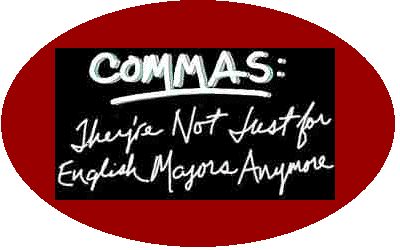
FIVE RULES TO COMMA GLORY
|
Don't Forget!:
|
YOU MUST HAVE A
REASON FOR EACH COMMA YOU USE. |
IE - Introductory
Elements
An introductory
element is a word, phrase, or clause before the main part of the sentence.
It usually tells us something about the main clause.
- If we cannot control our tempers, we may have to bite those
mimes.
- On the other hand, they may bite us first.
CE - Contrasting Elements
Use commas to set
up a strong contrast. Some key words: but, yet, not, never
Phineas, not Ferb, has a pointed face.
21C - Two Independent
Clauses
(a.k.a. "compound
sentences") When two independent clauses are joined with a coordinating (and
not any other kind of) conjunction, place a comma before the conjunction.
(Remember: FANBOYS!)
The Misfit takes the son's shirt, and he shoots the grandmother.
CA - Compound (or Coordinate)
Adjectives
Use commas to separate
consecutive adjectives:
The closet was full of old, worn clothes.
Do not, however, use a comma
when the order of the adjectives matters (i.e., when you can't simply reverse
them without seriously changing the meaning):
We were suspicious of the fried green
tomatoes.
(After
all, fried green tomatoes may taste good, but green fried tomatoes might
make you sick).
NRE -
Non-Restrictive Elements
These elements
are the ones known, often misleadingly, as "the part you could just take
out": parenthetical comments, direct address, appositives, transitional words
and phrases, etc.
The pressure of being a clown was enough, it seems, to make
even a brave man weep.
They can also appear at the
end of a sentence:
He wanted to run into the airplane propeller,
an act that would have dramatically shortened his life expectancy.
The clowns were scary, especially the sarcastic ones.
Copyright (C) 2022, Joseph Sigalas
|